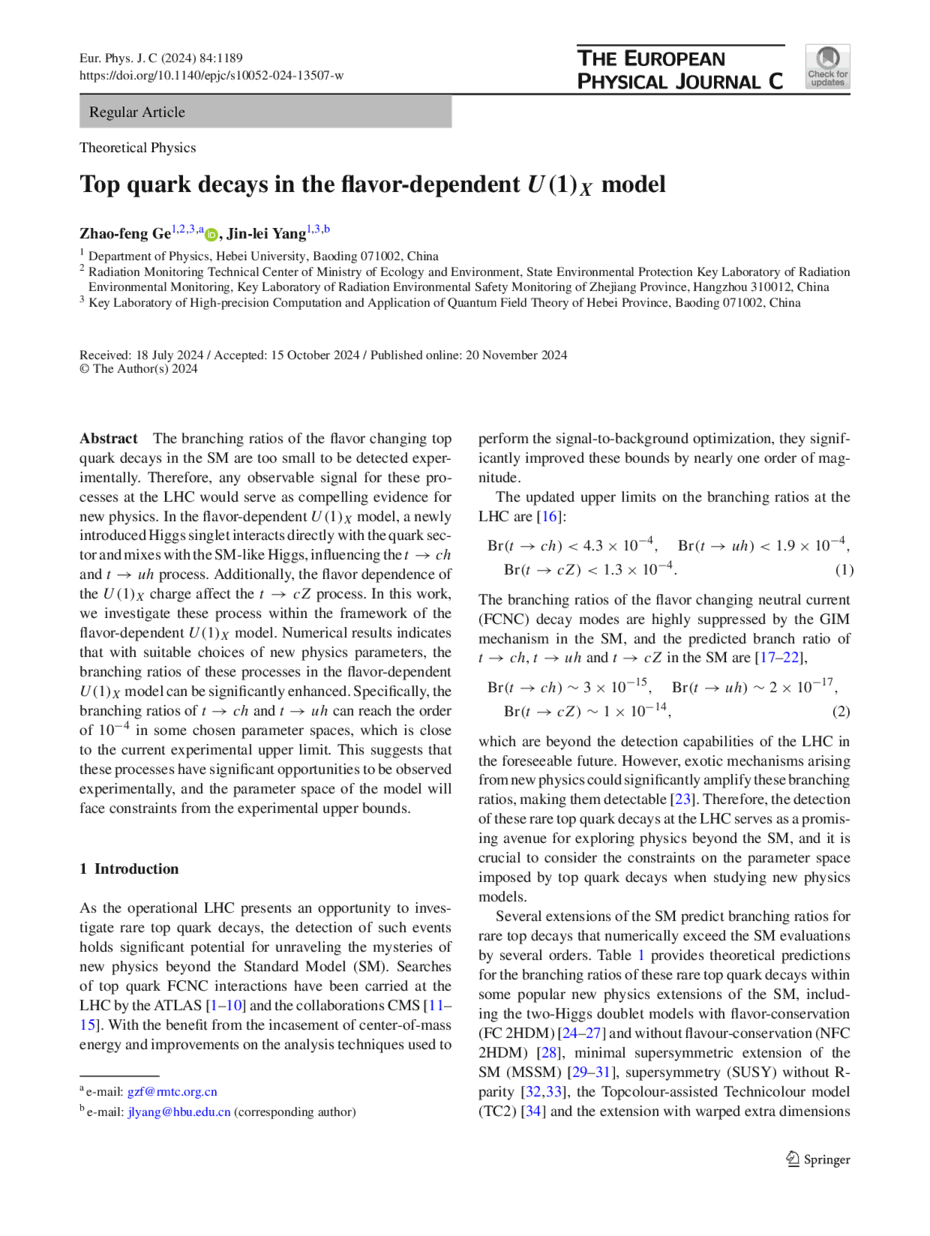https://doi.org/10.1140/epjc/s10052-024-13507-w
Regular Article
Top quark decays in the flavor-dependent  model
model
1
Department of Physics, Hebei University, 071002, Baoding, China
2
Radiation Monitoring Technical Center of Ministry of Ecology and Environment, State Environmental Protection Key Laboratory of Radiation Environmental Monitoring, Key Laboratory of Radiation Environmental Safety Monitoring of Zhejiang Province, 310012, Hangzhou, China
3
Key Laboratory of High-precision Computation and Application of Quantum Field Theory of Hebei Province, 071002, Baoding, China
Received:
18
July
2024
Accepted:
15
October
2024
Published online:
20
November
2024
The branching ratios of the flavor changing top quark decays in the SM are too small to be detected experimentally. Therefore, any observable signal for these processes at the LHC would serve as compelling evidence for new physics. In the flavor-dependent  model, a newly introduced Higgs singlet interacts directly with the quark sector and mixes with the SM-like Higgs, influencing the
model, a newly introduced Higgs singlet interacts directly with the quark sector and mixes with the SM-like Higgs, influencing the  and
and  process. Additionally, the flavor dependence of the
process. Additionally, the flavor dependence of the  charge affect the
charge affect the  process. In this work, we investigate these process within the framework of the flavor-dependent
process. In this work, we investigate these process within the framework of the flavor-dependent  model. Numerical results indicates that with suitable choices of new physics parameters, the branching ratios of these processes in the flavor-dependent
model. Numerical results indicates that with suitable choices of new physics parameters, the branching ratios of these processes in the flavor-dependent  model can be significantly enhanced. Specifically, the branching ratios of
model can be significantly enhanced. Specifically, the branching ratios of  and
and  can reach the order of
can reach the order of  in some chosen parameter spaces, which is close to the current experimental upper limit. This suggests that these processes have significant opportunities to be observed experimentally, and the parameter space of the model will face constraints from the experimental upper bounds.
in some chosen parameter spaces, which is close to the current experimental upper limit. This suggests that these processes have significant opportunities to be observed experimentally, and the parameter space of the model will face constraints from the experimental upper bounds.
© The Author(s) 2024
 Open Access This article is licensed under a Creative Commons Attribution 4.0 International License, which permits use, sharing, adaptation, distribution and reproduction in any medium or format, as long as you give appropriate credit to the original author(s) and the source, provide a link to the Creative Commons licence, and indicate if changes were made. The images or other third party material in this article are included in the article’s Creative Commons licence, unless indicated otherwise in a credit line to the material. If material is not included in the article’s Creative Commons licence and your intended use is not permitted by statutory regulation or exceeds the permitted use, you will need to obtain permission directly from the copyright holder. To view a copy of this licence, visit http://creativecommons.org/licenses/by/4.0/.
Open Access This article is licensed under a Creative Commons Attribution 4.0 International License, which permits use, sharing, adaptation, distribution and reproduction in any medium or format, as long as you give appropriate credit to the original author(s) and the source, provide a link to the Creative Commons licence, and indicate if changes were made. The images or other third party material in this article are included in the article’s Creative Commons licence, unless indicated otherwise in a credit line to the material. If material is not included in the article’s Creative Commons licence and your intended use is not permitted by statutory regulation or exceeds the permitted use, you will need to obtain permission directly from the copyright holder. To view a copy of this licence, visit http://creativecommons.org/licenses/by/4.0/.
Funded by SCOAP3.





